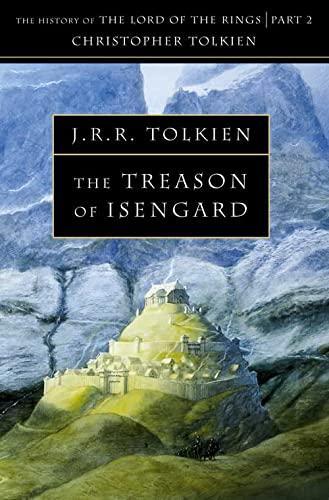History of The Lord of the Rings, 2/4
5 étoiles
History of Middle-Earth 7/12, History of The Lord of the Rings, 2/4
The Treason of Isengard was going to be a sub-title in the LOTR , taken now by Christopher to describe the second volume in retracing the composition of this tale. This current book is comprised of a Forward, 26 chapters with descriptive titles as to the stages of writing and their content, an Appendice on Runes, and an Index. It covers reorganizing and rewritings of the earliest chapters in the Fellowship of the Ring, before new material was conceived from the Mines of Moria to visiting the Halls of Rohan, which themselves would actually be part of the second volume in the Lord of the Rings, The Two Towers, with ever-growing plots, changes to geography, names, characters, relationships and precise order in sequence of events.
Following up on volume 1st in history of LOTR, and 6 of history of middle-earth, where Christopher Tolkien (C.T) had given his father's notes from August 1939, he now shows the reworking JRR started, based on these notes, basically immediately and until, more or less, winter of 1941-1942.
The first chapter in the present book explains Gandalf's delay, followed by the fourth writing phase of the Fellowship of the Ring, in chapters II and III of this current book, covering those between Hobbiton, leaving to Bree, and from there, to The Ford of Rivendell.
As in the previous volume, Christopher gives only the variants as they were achieved in this period of August or September-October 1939, and adds only in commentary and notes where the passages equal one another, and those of the final published work, thus avoiding repetition of text. Here, we see how JRR finally changed Trotter from Hobbit in the previous versions and conceptions into a Man, and finally as a code-name for Aragorn - whose lineage changes several times, and doesn't reach the final form as of yet, and before the emergence of the code-name Strider.
We see how JRR kept shifting the names and number of hobbits present at the start of the story, before their final version arose in notes and emendations, and how he was revising his story in non-linear fashion, sometimes reworking on a later chapter, coming back to an earlier one, changing a name or concept in the process of writing, and going back to the later chapter to add corrections in pencil or pen, in a very intricate and sometimes complex process, which C.T as always had to back-work to find the origins where possible!
Chapter IV covers Hamilcar, Gandalf and Saruman, with conceptions presumed at first by JRR to have occured in the summer 1940 but shown as most probable to date from August 1939 as Christopher could retrace the stages up to this point, with several proofs as to the plausibility of this assumption.
Chapter V shows the progression from a 1933 poem Tolkien had wrote, Errantry, at first totally unrelated to Middle-Earth, to become, through rewording and various stages of composition, into the poem Bilbo recites on the story of Eärandel at the council of Elrond, to be fully integrated into the Legendarium!
Then, the Council of Elrond is studied in chapters VI (with 4 versions and their alterations), and VII (with a fifth, longer version) - C.T pointing, in the course of these, to some differences and the stories as they stood also seen in the Hobbit, the Silmarillon, and other tales from the Legendarium.
The Ring goes south's further changes are told in chapter VIII, whilst IX reached the final changes to the first portion of the Mines of Moria, where Tolkien had previously been stuck. In chapter X, we can read further elements of the story that Tolkien finally envisioned, based on his sketch from the summer 1939, detailing the departure from the the same Tomb in front of which he had been stuck, and to the end of the Mines - already with most of the content that would be retained from the published form.
Chapter XI deals with Tolkien's sketches with the story foreseen from Moria onwards, whereas chapters XII-XIV pertain to the company's arrival, stay and departure from Lothlórien, including, in XIV, the 8 main drafts changing conceptions of Galadriel's gifts to each member, and the very interesting analysis Christopher gives on the evolution of Aragaron's various names at this stage of composition, based on the shifts during this particular portion of the gifts.
The firs map of the LOTR is chapter XV, showing the interrelation of Tolkien's geographic conceptions as part of the evolving story, and chapter XVI gives further narratives as well as substantial outlines for the story foreseen from Lórien, but actually started - as shown by C.T. - before JRR had written the conclusion to Farewell to Lothlórien. Earliest details were still very far from the published form, and yet, during their composition and notes JRR took, several elements would arise and later retained for the final version.
In chapters XVII to XIX we read the new material JRR composed, following some of his outlines, and then deviating from others, to much different content than he had initially planned, coming closer, in name, phrasing, and story, as the published form, for the fellowship's travels after they left Lórien by boat, to an unforeseen and drastic change in outcomes of several elements, with major plot twists that marked us in the final versions.
XX and XXI detail new changes in the course of composition, the new developments of the Rider of Rohan, called at the time Rohiroth, but already with several key-characters being named, and met during tracking of Orcs, just like the published form. We then learn of the new type of creatures, the Uruk-Hai, and in XXII of Treebeard.
Chapter XXIII is short,j representing notes on various topics, that C.T felt the best moment to introduce here, following in XXIV about the White Rider some of the company meet on their path following their separation from one another. Then, in XXV, the story that JRR planed to continue after the forest of Fangorn, and finally, XXVI, the King of the Golden Hall, which had several re-writings, all, at this stage, prior the several characters' conception, such as Faramir and Arwen who haven't been invented yet - with some dark plans at this stage of writing. It is also at this period that the nature of Wizards as Angels/Istari, has arisen, and to be contrasted with Unfinished Tales, which I have to read.
After all these 26 chapters, comes an appendix on runes : pages 452-460 is C.T's commentary, followed by his copy (p. 461-466) of his father's runes as they evolved through the years, from around the time he had reworked the Silmarillion (1937 as can be seen in History of Middle-Earth 4) , and finally, an index (466-504).

